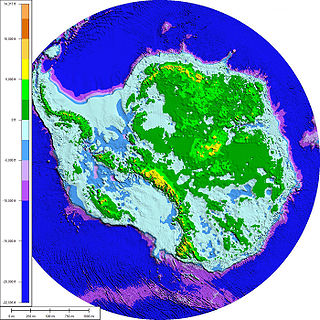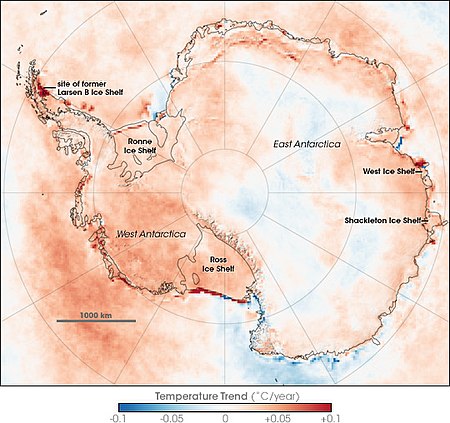
The cryosphere is an all-encompassing term for those portions of Earth's surface where water is in solid form, including sea ice, lake ice, river ice, snow cover, glaciers, ice caps, ice sheets, and frozen ground. Thus, there is a wide overlap with the hydrosphere. The cryosphere is an integral part of the global climate system with important linkages and feedbacks generated through its influence on surface energy and moisture fluxes, clouds, precipitation, hydrology, atmospheric and oceanic circulation. Through these feedback processes, the cryosphere plays a significant role in the global climate and in climate model response to global changes. The term deglaciation describes the retreat of cryospheric features. Cryology is the study of cryospheres.

The climate of Antarctica is the coldest on Earth. The continent is also extremely dry, averaging 166 mm (6.5 in) of precipitation per year. Snow rarely melts on most parts of the continent, and, after being compressed, becomes the glacier ice that makes up the ice sheet. Weather fronts rarely penetrate far into the continent, because of the katabatic winds. Most of Antarctica has an ice-cap climate with very cold, generally extremely dry weather.

An ice sheet, also known as a continental glacier, is a mass of glacial ice that covers surrounding terrain and is greater than 50,000 km2 (19,000 sq mi). The only current ice sheets are in Antarctica and Greenland; during the last glacial period at Last Glacial Maximum (LGM) the Laurentide Ice Sheet covered much of North America, the Weichselian ice sheet covered northern Europe and the Patagonian Ice Sheet covered southern South America.

The Antarctic Peninsula, known as O'Higgins Land in Chile and Tierra de San Martin in Argentina, and originally as the Palmer Peninsula in the US and Graham Land in the United Kingdom, is the northernmost part of the mainland of Antarctica.

The Western Antarctic Ice Sheet (WAIS) is the segment of the continental ice sheet that covers West Antarctica, the portion of Antarctica on the side of the Transantarctic Mountains which lies in the Western Hemisphere. The WAIS is classified as a marine-based ice sheet, meaning that its bed lies well below sea level and its edges flow into floating ice shelves. The WAIS is bounded by the Ross Ice Shelf, the Ronne Ice Shelf, and outlet glaciers that drain into the Amundsen Sea.

A polar ice cap or polar cap is a high-latitude region of a planet, dwarf planet, or natural satellite that is covered in ice.

The Antarctic ice sheet is one of the two polar ice caps of the Earth. It covers about 98% of the Antarctic continent and is the largest single mass of ice on Earth. It covers an area of almost 14 million square kilometres and contains 26.5 million cubic kilometres of ice. A cubic kilometer of ice weighs approximately one metric gigaton, meaning that the ice sheet weighs 26,500,000 gigatons. Approximately 61 percent of all fresh water on the Earth is held in the Antarctic ice sheet, an amount equivalent to about 58 m of sea-level rise. In East Antarctica, the ice sheet rests on a major land mass, while in West Antarctica the bed can extend to more than 2,500 m below sea level.
The Greenland ice sheet is a vast body of ice covering 1,710,000 square kilometres (660,000 sq mi), roughly 79% of the surface of Greenland.

The global temperature record shows the fluctuations of the temperature of the atmosphere and the oceans through various spans of time. The most detailed information exists since 1850, when methodical thermometer-based records began. There are numerous estimates of temperatures since the end of the Pleistocene glaciation, particularly during the current Holocene epoch. Older time periods are studied by paleoclimatology.

The retreat of glaciers since 1850 affects the availability of fresh water for irrigation and domestic use, mountain recreation, animals and plants that depend on glacier-melt, and, in the longer term, the level of the oceans. Studied by glaciologists, the temporal coincidence of glacier retreat with the measured increase of atmospheric greenhouse gases is often cited as an evidentiary underpinning of global warming. Mid-latitude mountain ranges such as the Himalayas, Rockies, Alps, Cascades, and the southern Andes, as well as isolated tropical summits such as Mount Kilimanjaro in Africa, are showing some of the largest proportionate glacial losses.
The Antarctic Cold Reversal (ACR) was an important episode of cooling in the climate history of the Earth during the deglaciation at the close of the last ice age. It illustrates the complexity of the climate changes at the transition from the Pleistocene to the Holocene Epochs.

The effects of global warming in the Arctic, or climate change in the Arctic include rising air and water temperatures, loss of sea ice, and melting of the Greenland ice sheet with a related cold temperature anomaly, observed since the 1970s. Related impacts include ocean circulation changes, increased input of freshwater, and ocean acidification. Indirect effects through potential climate teleconnections to mid latitudes may result in a greater frequency of extreme weather events, ecological, biological and phenology changes, biological migrations and extinctions, natural resource stresses and as well as human health, displacement and security issues. Potential methane releases from the region, especially through the thawing of permafrost and methane clathrates, may occur. Presently, the Arctic is warming twice as fast as the rest of the world. The pronounced warming signal, the amplified response of the Arctic to global warming, is often seen as a leading indicator of global warming. The melting of Greenland's ice sheet is linked to polar amplification. According to a study published in 2016, about 0.5 °C (0.90 °F) of the warming in the Arctic has been attributed to reductions in sulfate aerosols in Europe since 1980.

The Antarctica cooling controversy was the result of an apparent contradiction in the observed cooling behavior of Antarctica between 1966 and 2000 became part of the public debate in the global warming controversy, particularly between advocacy groups of both sides in the public arena including politicians, as well as the popular media. In his novel State of Fear, Michael Crichton asserted that the Antarctic data contradict global warming. The few scientists who have commented on the supposed controversy state that there is no contradiction, while the author of the paper whose work inspired Crichton's remarks has said that Crichton misused his results. There is no similar controversy within the scientific community, as the small observed changes in Antarctica are consistent with the small changes predicted by climate models, and because the overall trend since comprehensive observations began is now known to be one of warming.

The East Antarctic Ice Sheet (EAIS) is one of two large ice sheets in Antarctica, and the largest on the entire planet. The EAIS lies between 45° west and 168° east longitudinally.

Antarctica is Earth's southernmost continent. It contains the geographic South Pole and is situated in the Antarctic region of the Southern Hemisphere, almost entirely south of the Antarctic Circle, and is surrounded by the Southern Ocean. At 14,200,000 square kilometres, it is the fifth-largest continent and nearly twice the size of Australia. At 0.00008 people per square kilometre, it is by far the least densely populated continent. About 98% of Antarctica is covered by ice that averages 1.9 km in thickness, which extends to all but the northernmost reaches of the Antarctic Peninsula.

Since at least the start of the 20th century, the average global sea level has been rising. Between 1900 and 2016, the sea level rose by 16–21 cm (6.3–8.3 in). More precise data gathered from satellite radar measurements reveal an accelerating rise of 7.5 cm (3.0 in) from 1993 to 2017, which is a trend of roughly 30 cm (12 in) per century. This acceleration is due mostly to human-caused global warming, which is driving thermal expansion of seawater and the melting of land-based ice sheets and glaciers. Between 1993 and 2018, thermal expansion of the oceans contributed 42% to sea level rise; the melting of temperate glaciers, 21%; Greenland, 15%; and Antarctica, 8%. Climate scientists expect the rate to further accelerate during the 21st century.

Climate change causes a variety of physical impacts on the climate system. The physical impacts of climate change foremost include globally rising temperatures of the lower atmosphere, the land, and oceans. Temperature rise is not uniform, with land masses and the Arctic region warming faster than the global average. Effects on weather encompass increased heavy precipitation, reduced amounts of cold days, increase in heat waves and various effects on tropical cyclones. The enhanced greenhouse effect causes the higher part of the atmosphere, the stratosphere, to cool. Geochemical cycles are also impacted, with absorption of CO
2 causing ocean acidification, and rising ocean water decreasing the ocean's ability to absorb further carbon dioxide. Annual snow cover has decreased, sea ice is declining and widespread melting of glaciers is underway. Thermal expansion and glacial retreat cause sea levels to increase. Retreat of ice mass may impact various geological processes as well, such as volcanism and earthquakes. Increased temperatures and other human interference with the climate system can lead to tipping points to be crossed such as the collapse of the thermohaline circulation or the Amazon rainforest. Some of these physical impacts also affect social and economic systems.

Antarctic sea ice is the sea ice of the Southern Ocean. It extends far north in winter and retreats almost to the coastline each summer. Sea ice is frozen seawater that is usually less than a few metres thick. This is in contrast to ice shelves, which are formed by glaciers, float in the sea, and are up to a kilometer thick. There are two subdivisions of sea ice: fast ice, which is attached to land; and ice floes, which are not.
The Ice Sheet Mass Balance Inter-comparison Exercise (IMBIE) is an international scientific collaboration attempting to improve estimates of the Antarctic and Greenland ice sheet contribution to sea level rise and to publish data and analyses concerning these subjects. IMBIE was founded in 2011 and is a collaboration between the European Space Agency (ESA) and the National Aeronautics and Space Administration (NASA) of the United States, and contributes to assessment reports of the Intergovernmental Panel on Climate Change (IPCC). IMBIE has led to improved confidence in the measurement of ice sheet mass balance and the associated global sea-level contribution. The improvements were achieved through combination of ice sheet imbalance estimates developed from the independent satellite techniques of altimetry, gravimetry and the input-output method. Going forwards, IMBIE provides a framework for assessing ice sheet mass balance, and has an explicit aim to widen participation to enable the entire scientific community to become involved.

Amelia E. Shevenell is an American marine geologist who specializes in high-latitude paleoclimatology and paleoceanography. She is currently an Associate Professor in the College of Marine Science at the University of South Florida. She has made notable contributions to understanding the history of the Antarctic ice sheets and published in high-impact journals and, as a result, was awarded full membership of Sigma Xi. She has a long record of participation in international ocean drilling programs and has served in leadership positions of these organizations. Shevenell is the elected Geological Oceanography Council Member for The Oceanography Society (2019-2021).



















